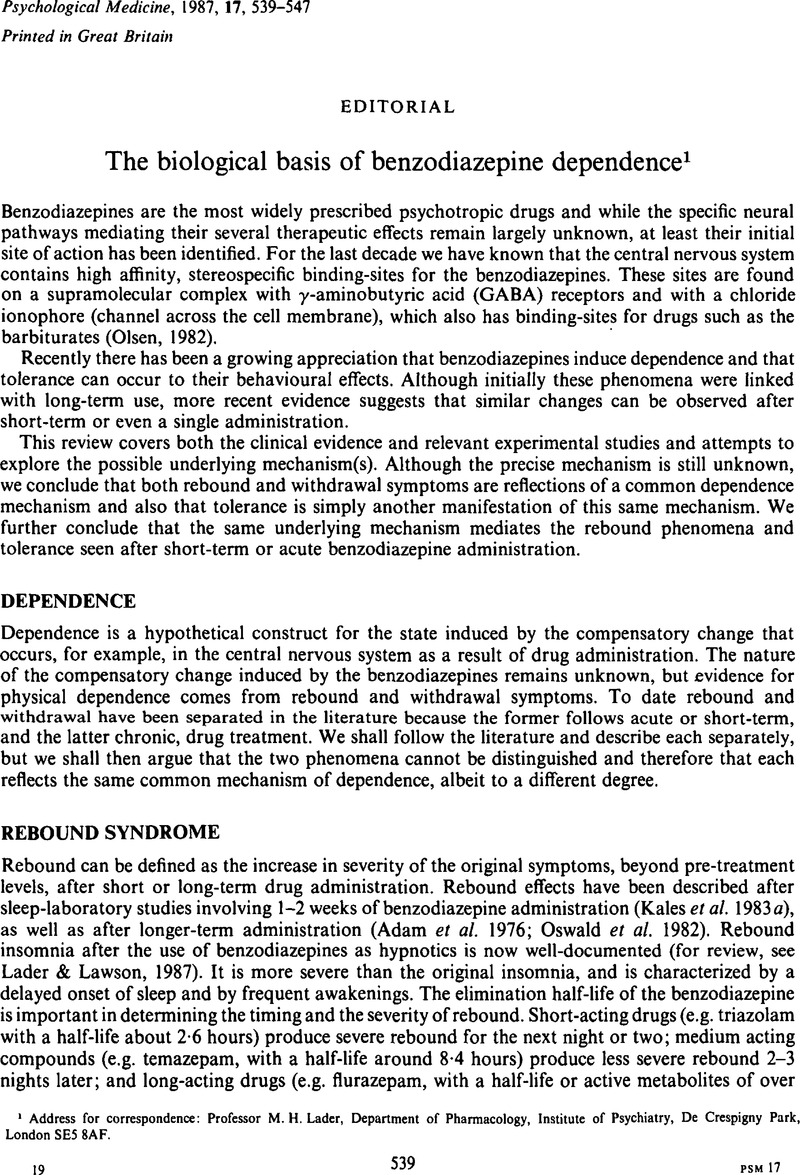Crossref Citations
This article has been cited by the following publications. This list is generated based on data provided by Crossref.
File, S.E.
and
Pellow, S.
1987.
Behavioral pharmacology of minor tranquilizers.
Pharmacology & Therapeutics,
Vol. 35,
Issue. 3,
p.
265.
File, Sandra E.
Baldwin, Helen A.
and
Aranko, Kari
1987.
Anxiogenic effects in benzodiazepine withdrawal are linked to the development of tolerance.
Brain Research Bulletin,
Vol. 19,
Issue. 5,
p.
607.
File, Sandra E.
Wilks, Lucy J.
and
Mabbutt, P.S.
1988.
Withdrawal, tolerance and sensitization after a single dose of lorazepam.
Pharmacology Biochemistry and Behavior,
Vol. 31,
Issue. 4,
p.
937.
Féline, A.
1988.
L’utilisation Pratique des Benzodiazépines dans le Traitement des Troubles Anxieux.
Psychiatry and Psychobiology,
Vol. 3,
Issue. S2,
p.
183s.
Higgitt, A.
Fonagy, P.
and
Lader, M.
1988.
The natural history of tolerance to the benzodiazepines.
Psychological Medicine. Monograph Supplement,
Vol. 13,
Issue. ,
p.
1.
Lader, M.
1988.
Psychopharmacology: Current Trends.
p.
169.
Feely, M.P.
and
Haigh, J.R.M.
1988.
DIFFERENCES BETWEEN BENZODIAZEPINES.
The Lancet,
Vol. 331,
Issue. 8600,
p.
1460.
Sussman, Norman
and
Chou, James C Y
1988.
Current Issues in Benzodiazepine Use for Anxiety Disorders.
Psychiatric Annals,
Vol. 18,
Issue. 3,
p.
139.
1989.
Communications.
British Journal of Pharmacology,
Vol. 97,
Issue. S1,
Schifano, Fabrizio
and
Magni, Guido
1989.
Panic Attacks and Major Depression after Discontinuation of Long-Term Diazepam Abuse.
DICP,
Vol. 23,
Issue. 12,
p.
989.
Iwaya, Nobuaki
Morita, Yoshio
and
Miyoshi, Koho
1989.
Determination of Pharmacodynamics of Diazepam by Quantitative Pharmaco‐EEG.
Psychiatry and Clinical Neurosciences,
Vol. 43,
Issue. 4,
p.
675.
Feely, Morgan
Boyland, Penelope
Picardo, Amanda
Cox, Anthony
and
Paul Gent, J.
1989.
Lack of anticonvulsant tolerance with RU 32698 and Ro 17-1812.
European Journal of Pharmacology,
Vol. 164,
Issue. 2,
p.
377.
Sandra, E.
1989.
Chronic diazepam treatment: Effect of dose on development of tolerance and incidence of withdrawal in an animal test of anxiety.
Human Psychopharmacology: Clinical and Experimental,
Vol. 4,
Issue. 1,
p.
59.
Taylor, F. Kräupl
1989.
The Damnation of Benzodiazepines.
British Journal of Psychiatry,
Vol. 154,
Issue. 5,
p.
697.
Lader, Malcolm
1989.
Benzodiazepine Dependence.
International Review of Psychiatry,
Vol. 1,
Issue. 1-2,
p.
149.
Schmidt, L. G.
Grohmann, R.
Müller-Oerlinghausen, B.
Otto, M.
Rüther, E.
and
Wolf, B.
1989.
Prevalence of Benzodiazepine Abuse and Dependence In-Psychiatric In-Patients with Different Nosology.
British Journal of Psychiatry,
Vol. 154,
Issue. 6,
p.
839.
Hitchcott, P.K.
File, Sandra E.
Ekwuru, M.
and
Neal, M.J.
1990.
Chronic diazepam treatment in rats causes long‐lasting changes in central [3H]‐5‐hydroxytryptamine and [14C]‐γ‐aminobutyric acid release.
British Journal of Pharmacology,
Vol. 99,
Issue. 1,
p.
11.
File, Sandra E.
and
Wilks, Lucy J.
1990.
Changes in seizure threshold and aggression during chronic treatment with three anticonvulsants and on drug withdrawal.
Psychopharmacology,
Vol. 100,
Issue. 2,
p.
237.
Holm, Marthin
1990.
Intervention against Long-term use of Hypnotics/Sedatives in General Practice.
Scandinavian Journal of Primary Health Care,
Vol. 8,
Issue. 2,
p.
113.
Higgitt, A.
Fonagy, P.
Toone, B.
and
Shine, P.
1990.
The prolonged benzodiazepine withdrawal syndrome: anxiety or hysteria?.
Acta Psychiatrica Scandinavica,
Vol. 82,
Issue. 2,
p.
165.



